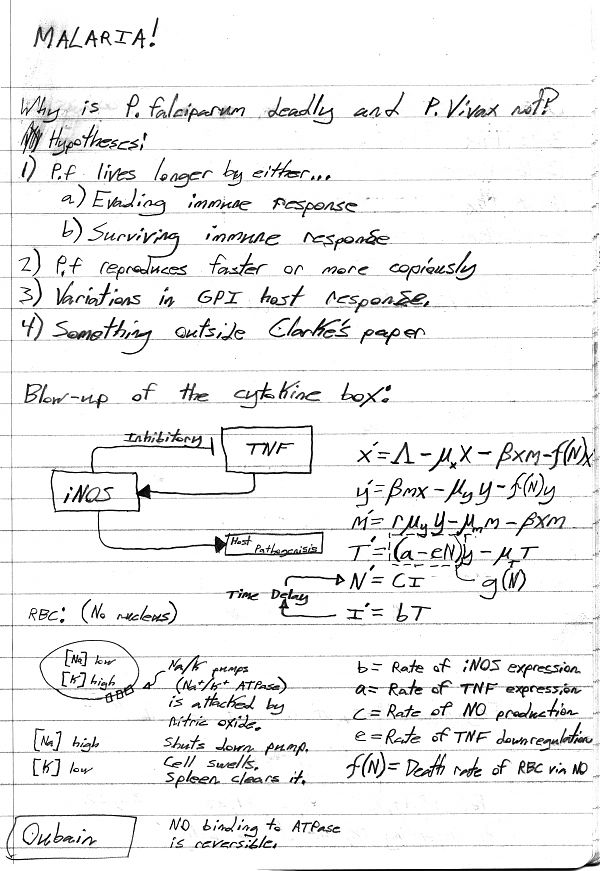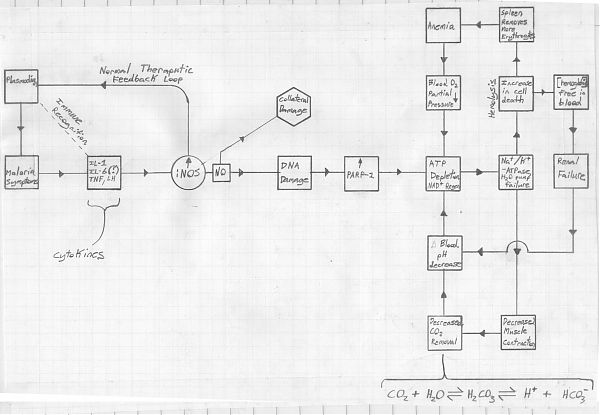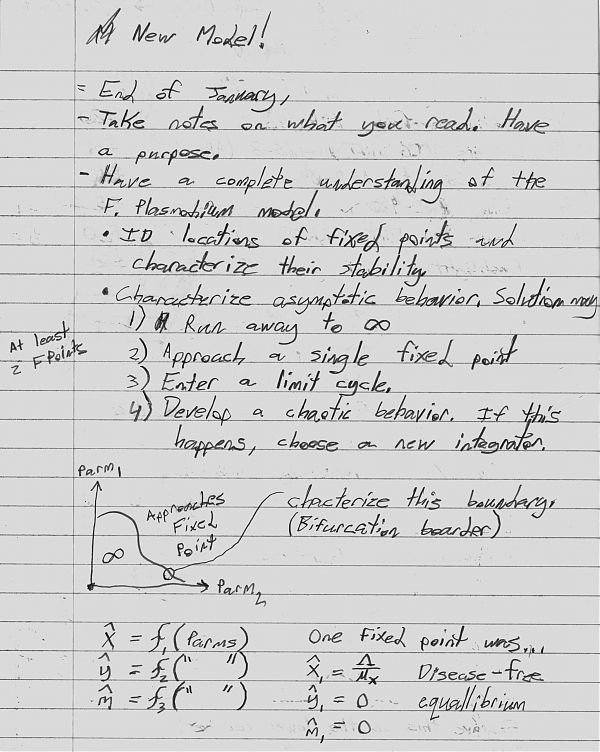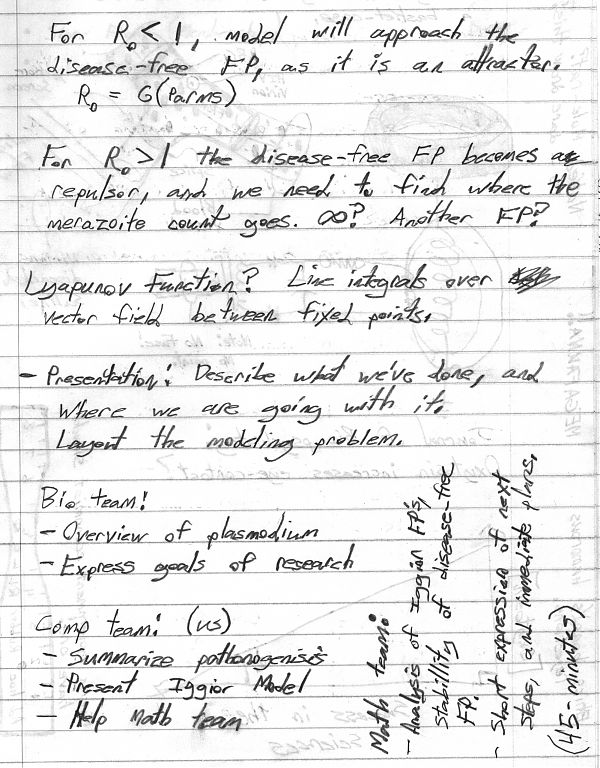SCC Malaria Research Team
2009-05-15 22:14 by Ian
My research team was in the news!
Scottsdale Community College – SCC Students Present Research Project at ASU Symposium
2019.08.08: Update
I found a bunch of my old notes while scanning papers from school. Figured I’d post them for the benefit of some discussions I’ve had recently on mathematical models. To that end, I will give some brief narrative surrounding the material. I will add more if/when I find it.
Here is the Malaria UBM Outline as put together by Dr. Nagy.
Before you can model a complex dynamic system, you have to give some careful thought to the thing in the world you are trying to model. It’s one thing to model a system that is already well-understood (as would be the case in most undergraduate physics courses). These are often cases where you want to figure out how much of what things you need to produce a given amount of something. But the model can be written from existing knowledge.
It is an entirely different thing for systems whose workings are not fully clear, or even unknown (climates, turbulence, neutron stars, and the interiors of living things). This model is the latter case; using a mathematical model to tease out things to look for in the real world. Since we shouldn’t intentionally infect people with diseases for the sake of understanding them, and since it’s too expensive or impossible to fully analyze many incidental cases to test the hypothesis, we build a mathematical model that represents our hypothesis and test it against conditions that we might plausibly find in the real world. If the model generates good predictions, it shortens the route to knowledge for experimentalists to find plausible causes for things in the real world.
Our research director, Dr. Nagy, found a hypothesis that was recently published which he believed merited attention. He wanted help refining and testing. He, myself and Michael Crusoe argued back and forth and at one point, made an initial (simple) toy model (not further discussed here) to see if the hypothesis was even feasible against idle attack. It passed, and we proceeded to spend the time to refine the hypothesis. Both for the sake of adding factors that we wanted initially, but were difficult to add, and for addressing weaknesses we found in the initial model. Here are some of my hand-written notes from a meeting near this time.

After lots of hard work reading existing literature and discussion, this is a schematic of the refined hypothesis that we put together in preparation for modeling:

This was drawn by my hand (because I suspect Michael liked how neatly I render things like this), but the idea represented was developed by the team from reading the papers posted below (among others).
Once we agreed on what we thought actually kills people and how it kills them we started a hard grind on representing the idea in a system of differential equations.
Here are some notes I took from a meeting where we were discussing specifics about the model.


It’s been awhile since I’ve looked at any of this stuff, but I think this DFE analysis was M. Crusoe’s work.
Here are my notes to my teammates who had made changes to the model that I was asked to help scrutinize and document for others. I won’t assume my reader has Maple installed, so here is a PDF render of the Maple sheet.
One of my teammates put together this nice overview of our model. And another turned our work into a presentation of our thesis.
The final draft of the poster used at the symposium.
Papers we used to inform our hypothesis, tune free parameters, or otherwise influenced our thinking
Mouse-over text are my notes on the value of the paper to our research efforts. There are still papers I haven’t dug out of the ice, but this is a good start.
- Pathogenesis of Malaria and Clinically Similar Conditions – Ian A. Clark, Lisa M. Alleva, Alison C. Mills, and William B. Cowden
- On global stability of the intra-host dynamics of malaria and the immune system – J. Tumwiine, J.Y.T. Mugisha, L.S. Luboobi
- The within-host cellular dynamics of bloodstage malaria, theoretical and experimental studies – C. Hetzel, R. M. Anderson
- NITRIC OXIDE INHIBITS LPS-INDUCED TUMOR NECROSIS FACTOR SYNTHESIS IN VITRO AND IN VIVO – Teresa Iuvone, Fulvio D’Acquisto, Rosa Carnuccio and h4assimo Di Rosa
- Tumour necrosis factor production in Falciparum malaria and its association with schizont rupture – D. KWIATKOWSKI, J. G. CANNON, K. R. MANOGUE, A. CERAMIt C. A. DINARELLO, B. M. GREENWOOD
- Nitric Oxide: Cytotoxicity versus Cytoprotection, How, Why, When, and Where? – Klaus-D. Kröncke, Karin Fehsel, and Victoria Kolb-Bachofen
- RED BLOOD CELL DEFORMABILITY AS A PREDICTOR OF ANEMIA IN SEVERE FALCIPARUM MALARIA – A. M. DONDORP, B.J.ANGUS, K. CHOTIVANICH, K. SILAMUT, R. RUANGVEERAYUTH, M.R. HARDEMAN, P.A. KAGER, J. VREEKEN, AND N. J. WHITE
- Life-spans of human T-cell responses to determinants from the circumsporozoite proteins of Plasmodium falciparum and Plasmodium vivax – Y. ZEVERING, C. KHAMBOONRUANGt, K. RUNGRUENGTHANAKITt, L. TUNGVIBOONCHAIt, J. RUENGPIPATTANAPANt, I. BATHURST, P. BARR, AND M. F. GOOD
- On the expression of nitric oxide synthase by human macrophages. Why no NO? – Jorge E. Albina
- Parasite-Derived Plasma Microparticles Contribute Significantly to Malaria Infection-Induced Inflammation through Potent Macrophage Stimulation – Kevin N. Couper, Tom Barnes, Julius C. R. Hafalla, Valery Combes, Bernhard Ryffel, Thomas Secher, Georges E. Grau, Eleanor M. Riley, J. Brian de Souza
- GLOBAL ANALYSIS OF NEW MALARIA INTRAHOST MODELS WITH A COMPETITIVE EXCLUSION PRINCIPLE – ABDERRHAMAN IGGIDR, JEAN-CLAUDE KAMGANG, GAUTHIER SALLET, AND JEAN-JULES TEWA
- Host Control of Malaria Infections: Constraints on Immune and Erythropoeitic Response Kinetics – Philip G. McQueen, F. Ellis McKenzie
- Top-down or Bottom-up Regulation of Intra-Host Blood-Stage Malaria: Do Malaria Parasites Most Resemble the Dynamics of Prey or Predator? – Daniel T. Haydon, Louise Matthews, Rebecca Timms, Nick Colegrave
- A Model for Estimating Total Parasite Load in Falciparum Malaria Patients – Mike B. Gravenor, Alun L. Lloydz, Peter G. Kremsnery, Michel A. Missinouy, Mike Englishw, Kevin Marsh, Dominic Kwiatkowski
- Cellular Basis of Early Cytokine Response to Plasmodium falciparum – MEIKE HENSMANN, DOMINIC KWIATKOWSKI
- Models for the in-host dynamics of malaria revisited, errors in some basic models lead to large over-estimates of growth rates – A. SAUL
- BIFURCATION ANALYSIS OF A MATHEMATICAL MODEL FOR MALARIA TRANSMISSION – NAKUL CHITNIS , J.M. CUSHING , J.M. HYMAN
- Antigenic variation and immune evasion in Plasmodium falciparum malaria – JOHN C REEDER, GRAHAM V BROWN
- Antibody responses to the merozoite surface protein-1 complex in cerebral malaria patients in India – Naomi W Lucchi, Jon Eric Tongren, Vidhan Jain, Avinash C Nagpal, Christian W Kauth, Ute Woehlbier, Hermann Bujard, Aditya P Dash, Neeru Singh, Jonathan K Stiles and Venkatachalam Udhayakumar
- Nitric Oxide Synthase mRNA in Endothelial Cells: Synergistic Induction by Interferon-gamma, Tumor Necrosis Factor-alpha and Lipopolysaccharide and Inhibition by Dexamethasone – Takeshi Marumo, Toshio Nakaki, Hiroko Adachi, Hiroyasu Esumi, Hiromichi Suzuki, Takao Saruta, Ryuichi Kato
Previous: Evil in the mirror
Next: Guitar Tab: 311 - Bomb the Town